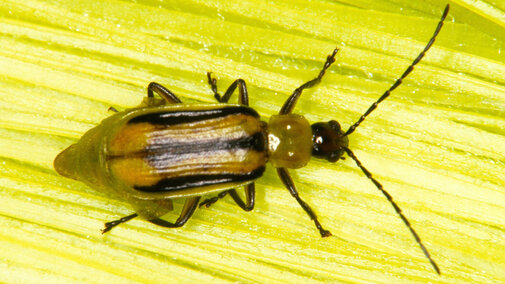Western corn rootworm beetles began emerging in late June-early July in southeastern and southcentral Nebraska. Beetle emergence was somewhat later in northeastern and western Nebraska. These beetles can cause potential injury from silk clipping.
During mid-July and August these beetles will lay eggs in corn fields. These eggs overwinter in the soil, hatch into rootworms in the spring, and feed on corn roots if continuous corn is grown. However, not all continuous corn fields have economic infestations of corn rootworms.
Scouting
Weekly scouting of adult rootworm beetles in July and August will provide the information needed to decide whether rootworm control is needed next year.
Start scouting for corn rootworm beetles soon after beetle emergence begins and continue scouting weekly until threshold levels are exceeded or beetle activity stops. Examine 50 plants per field, taking samples from each quarter of the field. Sampled plants should be several paces apart so examining one plant doesn’t drive beetles off the next plant to be sampled. The most reliable method is to examine the whole plant for beetles. Beetles may hide behind leaf sheaths or in the silks, so take care to observe all beetles present.
In continuous corn if beetle counts exceed the thresholds noted in Table 1, damaging populations of corn rootworms are possible in that field next year. In first year corn, there is a higher proportion of female beetles, so the threshold is lowered compared to those in continuous corn. The number of beetles per plant to equal a threshold level should be adjusted for different plant populations (see Table 1).
Another scouting method for adult rootworm beetles is to use Pherocon AM yellow sticky traps (unbaited). Traps should be placed on the plant at ear level. In this case, the treatment threshold is an average of two beetles/trap/day.
In fields with insect levels over the threshold, next year consider:
- rotating out of corn,
- planting a pyramided transgenic corn expressing the Cry34/35 protein and another protein active against rootworms (see Handy Bt Trait Table for more information), or
- using an insecticide at planting on non-Bt corn to prevent economic damage.
Fields remaining below the threshold level throughout the beetle egg-laying period are not expected to have economic populations of rootworms next year.

| Plants per acre | Average number of rootworm beetles per plant Continuous Corn1 | Average number of rootworm beetles per plant First-year Corn2,3 |
|---|---|---|
| 18,000 | 1 | 0.75 |
| 20,000 | 0.9 | 0.68 |
| 22,000 | 0.81 | 0.61 |
| 24,000 | 0.75 | 0.56 |
| 26,000 | 0.69 | 0.52 |
| 28,000 | 0.64 | 0.48 |
| 30,000 | 0.6 | 0.45 |
| 32,000 | 0.56 | 0.42 |
| 34,000 | 0.53 | 0.4 |
1Based on a 50:50 ratio of females to males.
2Based on a 70:30 ratio of females to males.
3Use this threshold for continuous corn fields that did not have larval populations earlier in the season (i.e., adult beetles are immigrants, similar to first year corn). During late July and August these beetles will lay eggs in corn fields. These eggs overwinter in the soil, hatch into rootworms in the spring, and feed on corn roots if continuous corn is grown. However, not all continuous corn fields have economic infestations of corn rootworms.
Adult Beetle Control
For adult beetle control programs, decisions as to whether to treat and if so, when to spray, should be based on information from field scouting. Individuals using adult beetle control programs to reduce egg laying should begin treatments when the beetle threshold is exceeded and 10% of the female beetles are gravid (abdomen visibly distended with eggs). This is an important point since the first beetles to emerge are mostly male, and females require at least 10-14 days of feeding before they can lay eggs. Treatments applied too early may be ineffective if large numbers of females emerge after the residual effectiveness of the treatment has dissipated.
People may want to include an insecticide at tasseling tank mixed with a fungicide to potentially control western bean cutworm and western corn rootworm beetles with one application. The optimal timing for fungicide and insecticide applications may not coincide and not all fields receiving fungicide applications have insect populations exceeding threshold levels. Therefore, it should be carefully considered whether a tank mix application at tasseling will provide an economic return.
Continue to monitor fields weekly after treatment for rootworm beetles. Due to the availability of fresh silks, late-maturing fields are particularly susceptible to corn rootworms moving into them from nearby earlier maturing fields and may need to be retreated.
A variety of insecticides are labeled against western corn rootworm beetles. See the EC 130, or product labels for rates and restrictions.
Be aware that resistance to the pyrethroid insecticide active ingredient, bifenthrin, has been documented in parts of southwest Nebraska. For more information see the Corn Rootworm Management Update.

